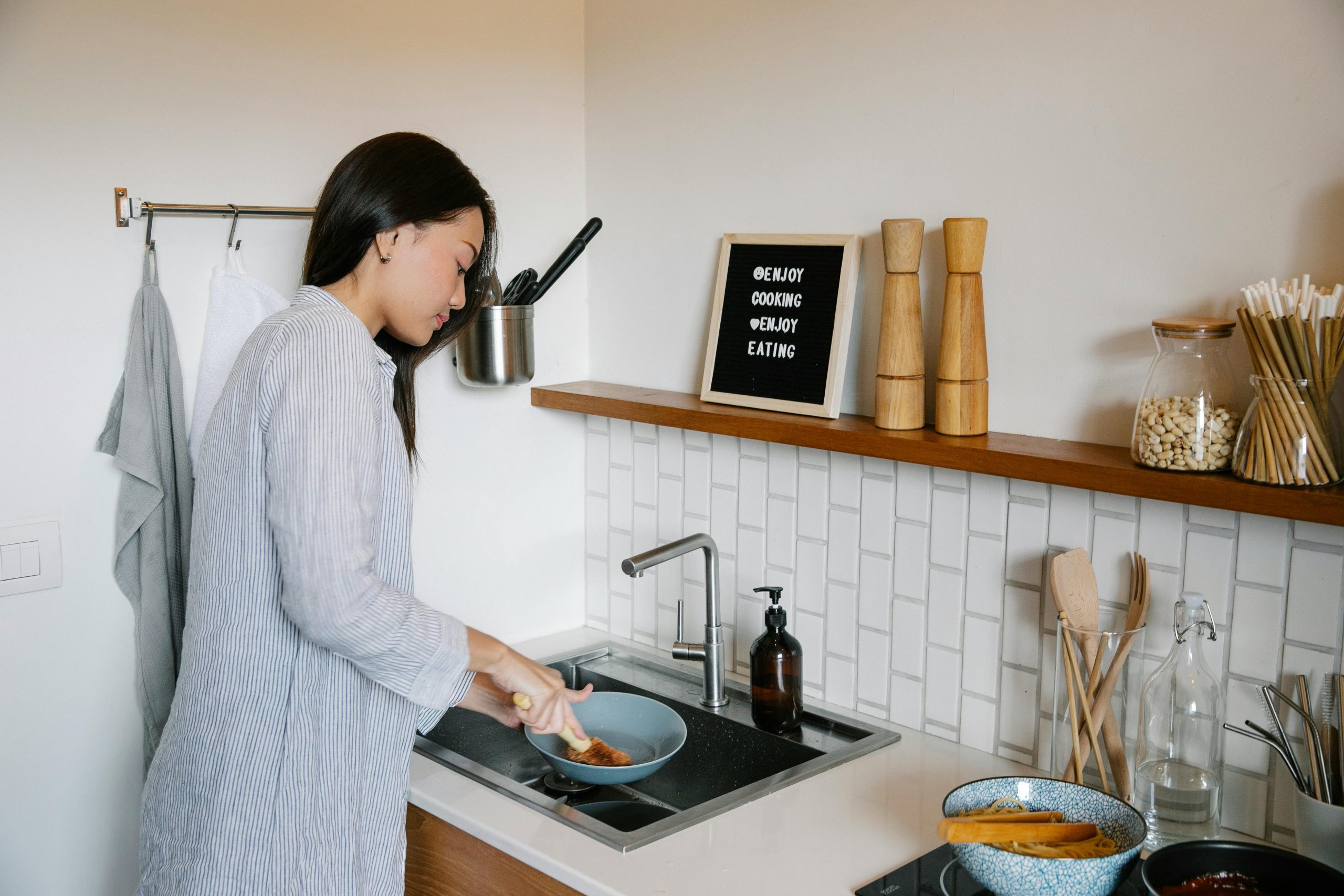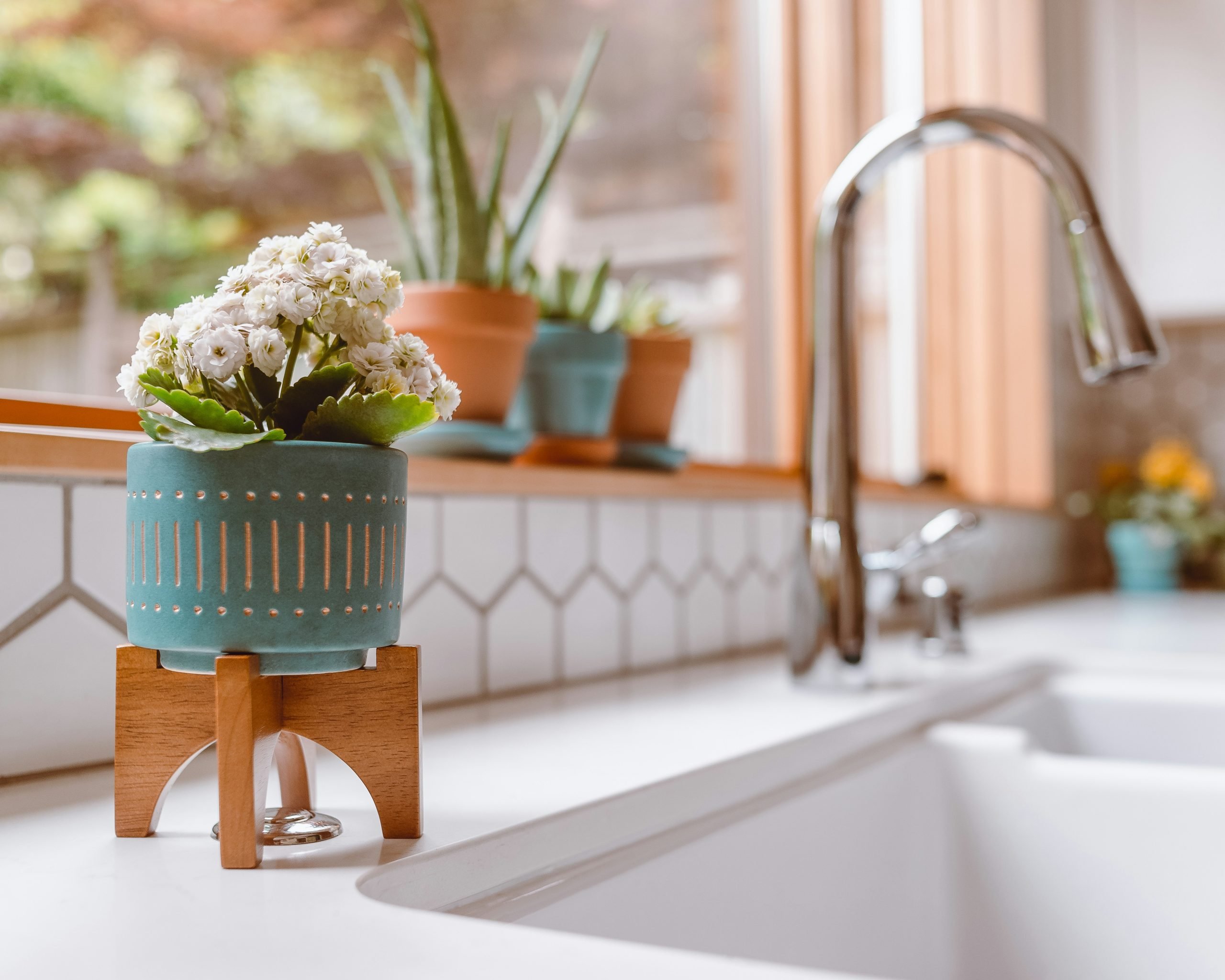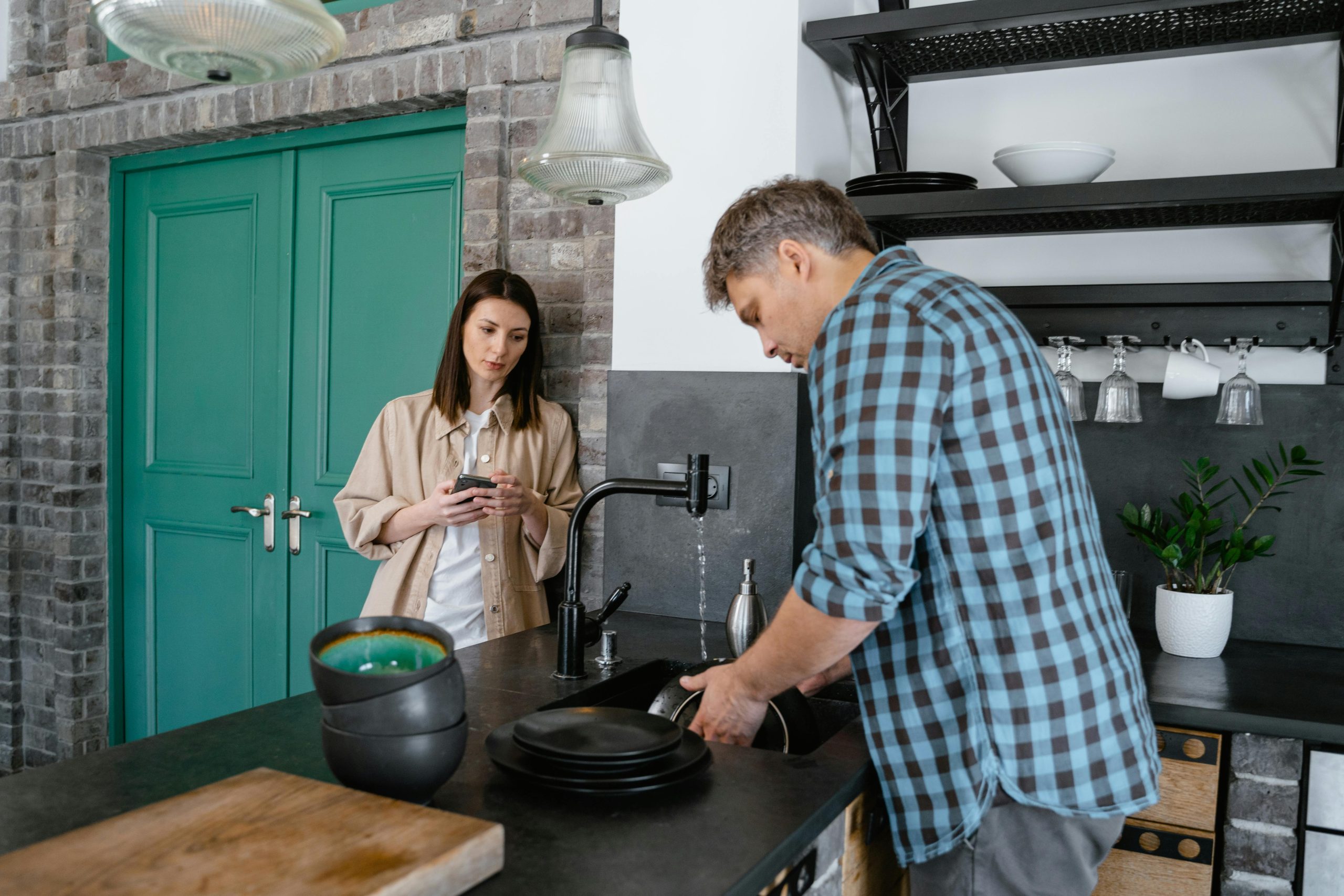A clogged kitchen sink – it’s a household woe that can turn a routine day into a plumbing predicament. The inconvenience of a slow-draining or completely blocked sink is a scenario many of us are familiar with, often striking at the most inconvenient times. The good news? You don’t always need to summon a plumber to the rescue. In this comprehensive guide, we’ll empower you with the knowledge to tackle the issue head-on and unclog your kitchen sink with do-it-yourself (DIY) methods that are both effective and, importantly, easy to execute.
As we delve into the intricacies of sink unclogging, we’ll start by understanding the common culprits behind these kitchen sink nuisances. By identifying the root causes, you can tailor your approach and select the most suitable method for a swift resolution. From there, we’ll equip you with the right tools and materials, ensuring you have everything needed to face the challenge confidently.
But we won’t stop at the basics. This guide goes beyond the conventional plunger, exploring natural drain cleaners and mechanical methods, giving you a diverse set of options to choose from based on the severity of the clog. Our aim is not just to help you address the current issue but to provide insights into preventing future sink blockages.
So, if you’re tired of standing over a sink filled with stagnant water or battling unpleasant odors, join us on this journey to reclaim control over your kitchen plumbing. Let’s dive into the world of DIY sink unclogging – a skill every homeowner should have in their toolkit. Say goodbye to the frustration, and hello to a smoothly flowing kitchen sink.

Understanding the Culprits
A clogged kitchen sink is often the result of a silent accumulation of various elements that find their way down the drain, disrupting the smooth flow of water. To effectively combat these nuisances, it’s crucial to discern between the types of culprits causing the obstruction. Understanding the culprits allows you to tailor your approach and choose the most suitable method for a successful unclogging mission.
Food Particles and Grease Buildup
One of the primary instigators of kitchen sink clogs is the buildup of food particles and grease. Over time, even with the use of a garbage disposal unit, small food scraps can accumulate, creating a barrier within the pipes. Combined with grease and oils that congeal as they cool, these substances form a stubborn obstruction. This not only impedes the flow of water but also provides an ideal environment for further debris to latch onto, exacerbating the blockage.
To tackle this common issue, a proactive approach involves mindful disposal of kitchen waste. Scrape plates and utensils into the trash before rinsing them in the sink. Additionally, consider installing a drain strainer to catch larger food particles, preventing them from reaching the pipes.
Foreign Objects Causing Obstructions
Sometimes, it’s not just the usual suspects like food and grease causing the blockage. Foreign objects inadvertently finding their way into the sink can also play a significant role. From small utensils and pieces of plastic to non-disposable wipes, these items can accumulate and create a barrier within the plumbing.
Preventing this type of clog involves heightened awareness during kitchen activities. Educate household members to be cautious about what goes down the drain. Implementing a “sink-friendly” rule, where only water and liquid soap find their way into the pipes, can go a long way in averting these unexpected obstructions.
Understanding the culprits behind your kitchen sink clog is the first step toward effective resolution. By identifying whether it’s primarily organic matter or foreign objects causing the issue, you can proceed with targeted DIY methods, increasing the likelihood of success and preventing future occurrences.
DIY Tools and Materials
Equipped with an understanding of potential culprits, the next vital step in your DIY unclogging journey is gathering essential tools. While a plumber’s toolbox may seem daunting, a few key items can make a significant difference in resolving the issue without professional help.
Plunger Techniques and Usage
The reliable plunger is a classic tool for good reason – it’s effective and user-friendly. To maximize its potential, ensure a proper seal by filling the sink with enough water to cover the plunger’s bell. Place it over the drain, forming a tight seal, and push and pull rapidly to create suction, dislodging the clog.
For double-basin sinks, seal the adjacent drain to focus pressure on the clogged side. If the plunger doesn’t work initially, repeat the process before exploring other methods. It’s a simple yet powerful tool that should be a staple in every DIY plumber’s toolkit.
Zip-It Tool and Its Effectiveness
For hard-to-reach clogs just below the surface, the Zip-It tool is a game-changer. This slim, flexible plastic tool reaches into the drain, hooking onto hair, soap scum, and debris. Insert it, twist it, and pull it out to extract gunk, providing immediate relief to your slow-draining sink.
Note that the Zip-It tool is single-use but cost-effective for minor clogs. Keep a few on hand for quick and easy maintenance whenever your sink slows down.
Importance of Using Gloves and Safety Measures
Prioritize safety before any DIY plumbing. Wear protective gloves to shield your hands and consider safety glasses, especially when using chemical drain cleaners. Ensure a secure footing to prevent slips and falls. Position yourself comfortably, and have a bucket or towel on hand to catch splashing water during unclogging. Taking these precautions ensures a safer and more efficient DIY experience.
Armed with the right tools and safety measures, you’re well-prepared to unclog your kitchen sink. The combination of a plunger and the Zip-It tool, coupled with safety precautions, can often resolve minor clogs and restore your sink’s optimal functionality.

Natural Drain Cleaners
When it comes to unclogging your kitchen sink, nature offers powerful allies in household items that are both eco-friendly and effective. Say goodbye to harsh chemical drain cleaners and hello to natural solutions that tackle stubborn clogs without compromising your health or the environment.
Baking Soda and Vinegar Combination
A dynamic duo in DIY plumbing, baking soda and vinegar work wonders in unclogging your kitchen sink. Pour a cup of baking soda followed by a cup of white vinegar down the drain. The fizzing reaction helps break down grease and grime, acting as a natural foaming agent that pushes debris away. Let it sit for 15 minutes before flushing with hot water to wash away dissolved gunk. It’s a safe and cost-effective alternative to chemical cleaners.
Hot Water Flush with Salt
For a quick remedy, use hot water and salt. Boil water and pour it down the drain followed by half a cup of table salt. The hot water melts away grease and soap scum while salt aids in scrubbing away debris. Repeat as needed, incorporating this into your monthly maintenance routine.
Citrus Fruits for Grease
Citrus fruits, known for their natural degreasing properties, can be valuable in unclogging kitchen sinks. Drop citrus peels into the disposal and run cold water to let citrus oils break down grease. This method not only tackles clogs but also serves as a proactive measure to prevent future buildup. It’s a refreshing and aromatic solution for cleaner pipes.
By harnessing the power of these natural drain cleaners, you not only unclog your kitchen sink but also contribute to a greener and healthier home environment. Incorporate these methods into your regular maintenance routine, and you’ll be amazed at the results achieved with simple, eco-friendly ingredients.
Mechanical Methods
When natural remedies and basic tools fall short, it’s time to explore mechanical methods to tackle stubborn kitchen sink clogs. These involve using specialized tools designed to physically remove blockages and restore your sink to optimal performance. Let’s dive into these mechanical warriors that can break through the toughest clogs.
Plumbing Snakes: Navigating Stubborn Clogs
A plumbing snake, or auger, is a versatile tool designed to navigate through pipes and dislodge stubborn clogs. Featuring a long, flexible cable with a coiled auger bit, it can break apart and pull out debris causing blockages. Handheld or hand-cranked snakes are recommended for kitchen sinks due to their maneuverability in tight spaces.
To use a plumbing snake effectively, insert it into the drain, rotate the handle clockwise, and gradually break through the clog. If resistance is encountered, gently wiggle and twist the snake to navigate around bends. Slowly retract the snake while rotating the handle to dislodge and pull out debris. This method is ideal for clogs beyond the reach of simpler tools.
Proper Snaking Techniques
Maximize the effectiveness of a plumbing snake by following a step-by-step approach. Insert it into the drain, turn the handle clockwise, and navigate through the obstruction. If the snake can’t advance, gently wiggle it to bypass bends. Slowly retract the snake while rotating the handle to dislodge and pull out debris. Repeat if necessary and finish by flushing the drain with hot water. While effective, avoid common mistakes, such as using excessive force or failing to secure the snake properly.
Common Mistakes to Avoid
Using a plumbing snake requires patience and precision. Avoid common mistakes like excessive force, which can damage the cable or pipes, and ensure proper securing before retracting to prevent getting stuck. If significant resistance is encountered, consider professional help to prevent further damage. With the right technique and caution, a plumbing snake can be a powerful ally against even the most obstinate kitchen sink clogs.

Prevention Tips
The saying “prevention is better than cure” rings true for maintaining a smoothly flowing kitchen sink. While unclogging methods are valuable, adopting preventive measures can save you from the hassle of dealing with persistent clogs. Let’s explore practical tips to keep your kitchen sink free from obstructions and ensure a trouble-free plumbing experience.
Proper Disposal of Kitchen Waste
One of the primary contributors to kitchen sink clogs is the improper disposal of food waste. To prevent debris buildup, make it a habit to scrape plates into the trash before rinsing them. Using a sink strainer can catch larger particles, reducing the risk of plumbing issues.
Educate your household about responsible waste disposal. Actions like emptying grease into a separate container instead of the drain can significantly reduce the likelihood of facing plumbing issues.
Regular Maintenance Routines for Sink Cleanliness
Incorporate regular maintenance into your kitchen sink care routine. Periodically clean your sink and pipes with natural solutions like baking soda and vinegar to eliminate potential clog culprits and prevent odors.
Schedule a monthly flush with hot water and salt to keep pipes clear of grease and soap scum. Consistency is key, and these routine actions can be proactive measures to avoid sudden clogs.
Best Practices for Preventing Kitchen Sink Clogs
In addition to responsible waste disposal and regular maintenance, follow best practices for daily kitchen use. Avoid pouring coffee grounds, oils, and fats down the drain. Run cold water while using the garbage disposal to ensure effective particle flushing.
For garbage disposal units, periodically grind citrus peels or ice cubes to clean the blades. Stay vigilant for signs of slow drainage or unusual sounds, as these could be early indicators of potential clogs. By staying proactive and implementing these prevention tips, you can enjoy a consistently trouble-free kitchen sink experience.
When to Seek Professional Help
While DIY methods can address many kitchen sink clogs, persistent issues may indicate deeper plumbing problems that require professional attention. Signs such as recurrent clogs in multiple drains or unusual sounds during drainage should prompt consideration of expert intervention. Ignoring these signs could lead to extensive damage and costly repairs.
Service by Scott, a trusted family-owned plumbing company in Woodville, Texas, offers over 30 years of dedicated service to Tyler County and neighboring areas. Our team of fully licensed professionals specializes in diagnosing and resolving complex plumbing issues. From slab leak detection to water heater maintenance, we provide comprehensive solutions for both residential and commercial clients.
When DIY efforts fall short, Service by Scott is ready to step in with timely and efficient plumbing services. With our 24/7 emergency service availability, we ensure that your plumbing concerns are addressed promptly, restoring functionality to your kitchen sink and plumbing system. Trust Service by Scott for expert solutions that stand the test of time.
Conclusion
In the pursuit of maintaining a smoothly flowing kitchen sink, our journey has taken us through a spectrum of DIY methods, natural remedies, and preventive measures. Armed with knowledge about the culprits behind clogs, essential tools, and eco-friendly solutions, you’re now equipped to face common plumbing challenges head-on.
Remember, prevention is key, and responsible waste disposal coupled with regular maintenance routines can significantly reduce the likelihood of encountering stubborn clogs. However, if your efforts fall short, and persistent issues arise, it’s essential to recognize the signs of a larger problem and seek professional help.
Service by Scott, a family-owned and operated full-service plumbing and maintenance company in Woodville, Texas, stands ready to assist. With over 30 years of dedicated service in Tyler County and neighboring areas, Service by Scott is your trusted partner for a wide range of plumbing needs. From routine inspections to addressing complex issues like slab leaks, our fully licensed professionals are committed to delivering reliable and efficient solutions.
Don’t let persistent clogs disrupt your daily routine or lead to more significant plumbing problems. Contact Service by Scott today for expert assistance, and let our team ensure that your kitchen sink and plumbing system operate seamlessly. Trust us to bring unparalleled expertise to your doorstep, providing you with the peace of mind that comes with a professionally maintained and efficiently functioning plumbing system.
Frequently Asked Questions (FAQs)
Can I use chemical drain cleaners to unclog my kitchen sink?
While chemical drain cleaners can be effective, they come with potential drawbacks. Harsh chemicals may damage pipes and harm the environment. We recommend exploring natural alternatives like baking soda and vinegar for a safer and eco-friendly solution.
How often should I unclog my kitchen sink?
The frequency of unclogging depends on usage and maintenance. Implement preventive measures like proper waste disposal and routine cleaning to reduce the need for unclogging. If you notice slow drainage, address it promptly to prevent more significant issues.
Are some sinks more prone to clogging than others?
Yes, certain sinks may be more prone to clogs based on their design and usage. Kitchen sinks with garbage disposals, for instance, can experience clogs due to food particles. Regular maintenance and adopting best practices can help mitigate these tendencies.
What if DIY methods don’t unclog my sink?
If DIY efforts prove unsuccessful, it may indicate a more complex issue. Persistent clogs could be a sign of blocked sewer lines or other plumbing problems. In such cases, seeking professional help, like the services offered by Service by Scott, is recommended for a thorough assessment.
How can I prevent kitchen sink clogs in the first place?
Prevention starts with responsible waste disposal. Scrape plates into the trash, avoid pouring grease down the drain, and use sink strainers to catch larger particles. Regular maintenance with natural remedies and occasional professional inspections can help keep your kitchen sink clog-free.

